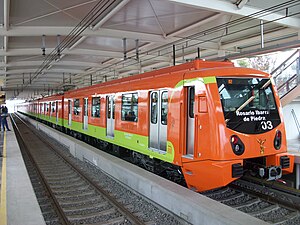
Back مترو مدينة مكسيكو Arabic Метрапалітэн Мехіка Byelorussian Мэтрапалітэн Мэхіка BE-X-OLD Metro v Ciudad de México Czech U-Bahn Mexiko-Stadt German Μετρό της Πόλης του Μεξικού Greek Metroo de Meksikurbo Esperanto Metro de la Ciudad de México Spanish Mexiko Hiriko metroa Basque متروی مکزیکو سیتی Persian
This article's lead section contains information that is not included elsewhere in the article. (February 2022) |
| Mexico City Metro | |||
|---|---|---|---|
 | |||
 | |||
| Overview | |||
| Native name | Sistema de Transporte Colectivo - Metro | ||
| Owner | Sistema de Transporte Colectivo (STC) | ||
| Area served | Greater Mexico City | ||
| Locale | Mexico City | ||
| Transit type | Rapid transit | ||
| Number of lines | 12[1] | ||
| Line number | 1-9, 12, A, B | ||
| Number of stations | 195[1] | ||
| Daily ridership | 4,534,383 (2019)[2] | ||
| Annual ridership | 1.655 billion (2019)[2] | ||
| Website | Metro de la Ciudad de México | ||
| Operation | |||
| Began operation | 4 September 1969[3] | ||
| Operator(s) | Sistema de Transporte Colectivo (STC) | ||
| Number of vehicles | 390[4] | ||
| Technical | |||
| System length | 200.9 km (124.8 mi) in revenue service; (226.5 km (140.7 mi) considering maintenance tracks)[5] | ||
| Track gauge | 1,435 mm (4 ft 8+1⁄2 in) standard gauge (2 lines); and roll ways along the outside of conventional standard gauge track (Rubber-tired metro) (10 lines) | ||
| |||
The Mexico City Metro (Spanish: Metro de la Ciudad de México) is a rapid transit system that serves the metropolitan area of Mexico City, including some municipalities in the State of Mexico. Operated by the Sistema de Transporte Colectivo (STC), it is the second largest metro system in North America after the New York City Subway.
The inaugural STC Metro line was 12.7 kilometres (7.9 mi) long, serving 16 stations, and opened to the public on 4 September 1969.[3] The system has expanded since then in a series of fits and starts. As of 2015[update], the system has 12 lines,[1] serving 195 stations,[1] and 226.49 kilometres (140.73 mi) of route.[1] Ten of the lines are rubber-tired. Instead of traditional steel wheels, they use pneumatic traction, which is quieter and rides smoother in Mexico City's unstable soils. The system survived the 1985 Mexico City earthquake.[6]
Of the STC Metro's 195 stations,[1] 44 serve two or more lines (correspondencias or transfer stations).[7] Many stations are named for historical figures, places, or events in Mexican history. It has 115 underground stations[1] (the deepest of which are 35 metres [115 ft] below street level); 54 surface stations[1] and 26 elevated stations.[1] All lines operate from 5 a.m. to midnight.[citation needed] At the end of 2007, the Federal District government announced the construction of the most recent STC Metro line, Line 12, which was built to run approximately 26 kilometres (16 mi)[8] towards the southeastern part of the city, connecting with Lines 7, 3, 2 and 8. This line opened on 30 October 2012.[9]
The Metro has figured in Mexico's cultural history, as the inspiration for a musical composition for strings, "Metro Chabacano"[10] and Rodrigo "Rockdrigo" González's 1982 song, "Metro Balderas". It was also a filming location for the 1990 Hollywood movie Total Recall.[11] Public intellectual Carlos Monsiváis has commented on the cultural importance of the Metro, "a space for collective expression, where diverse social sectors are compelled to mingle every day".[12]
- ^ a b c d e f g h i "Cifras de operación" [Operations figures] (in Spanish). Metro de la Ciudad de México. Archived from the original on 21 August 2016. Retrieved 20 August 2016.
- ^ a b "Afluencia de estación por línea 2019" (in Spanish). Metro CDMX. Archived from the original on 8 April 2021. Retrieved 27 April 2020.
- ^ a b "Inauguraciones y Ampliaciones en Orden Cronológico Hasta 2000" [Inaugurations and Extensions in Chronological Order Until 2000] (in Spanish). Metro de la Ciudad de Mexico. Archived from the original on 21 August 2016. Retrieved 20 August 2016.
- ^ "Parque Vehicular" [Vehicle Fleet] (in Spanish). Metro de la Ciudad de México. Archived from the original on 8 October 2016. Retrieved 20 August 2016.
- ^ "LONGITUDES DE LAS LINEAS" [Operations figures] (in Spanish). Metro de la Ciudad de México. Archived from the original on 21 August 2016. Retrieved 5 July 2018.
- ^ Luis M. Castañeda, Spectacular Mexico: Design, Propaganda, and the 1968 Olympics. Minneapolis: University of Minnesota Press 2014, p. 243
- ^ Coordinación de Desarrollo Tecnológico. "Clasificación de las estaciones por su uso y por su tipo" (in Spanish). Metro de la Ciudad de México. Archived from the original on 28 February 2017.
- ^ "Sabías Que... Linea 12" [Did You Know... Line 12] (in Spanish). Metro de la Ciudad de Mexico. Archived from the original on 17 September 2011. Retrieved 13 October 2013.
- ^ "Linea 12" [Line 12] (in Spanish). Metro de la Ciudad de Mexico. Archived from the original on 21 August 2016. Retrieved 20 August 2016.
- ^ "Metro Chabacano by Javier Álvarez". Archived from the original on 10 February 2020. Retrieved 14 September 2016 – via www.youtube.com.
- ^ Castañeda, Spectacular Mexico pp. 241-42.
- ^ Castañeda, Spectacular Mexico citing Monsiváis, "El metro: Viaje hacia el fin del apretujón," in Carlos Monsiváis, Los rituales del caos. Mexico City: Ediciones Era 1995, 109-10.
© MMXXIII Rich X Search. We shall prevail. All rights reserved. Rich X Search
